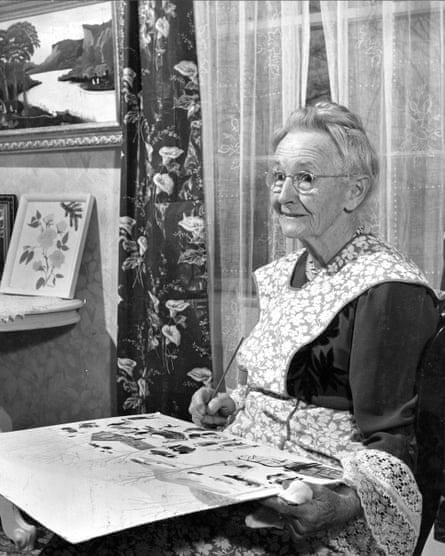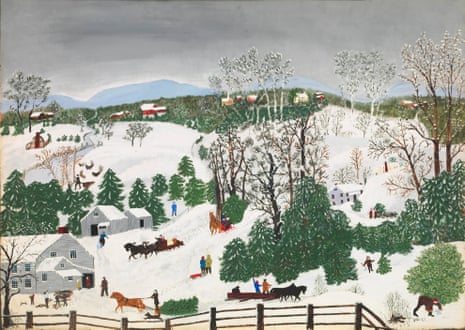‘I had always wanted to paint,” Anna Mary Robertson Moses once said. “But I just didn’t have time – until I was 76.” The artist, who became known as Grandma Moses, was hailed for her wide-eyed, childlike wonder which she channelled into paintings of often wintry landscapes depicting scenes of daily life.
Born in 1860, the third of 10 children raised on a farm in upstate New York, Moses became a servant for a wealthy neighbouring farmhouse at the age of 12, carrying out domestic duties such as cooking, sewing and cleaning. After 13 years of this, she married Thomas Salmon Moses and the couple went on to have 10 children – with only five surviving past infancy. Never wealthy, they settled on farms in Virginia and later in upstate New York, where Moses made crisps on the side for extra income.
In 1927, after Thomas died from a heart attack, their son Forrest was tasked with helping his mother look after the farm. When Moses later moved in with her daughter, she adopted the monikers Mother Moses or Grandma Moses, and her life began to change. Although she was a lifelong embroiderer, who had spent her evenings making quilts for friends and relatives, she developed arthritis at the age of 76. It was the mid-1930s and Moses turned instead to painting, after her sister suggested that a brush might be easier to hold than a needle. “If I didn’t start painting,” Moses once joked, “I would have raised chickens.”
Painting from her vivid imagination – without even an easel and using her bedroom or kitchen as a studio – Moses drew on the joyous memories of her long life. She employed simple, formulaic methods, painting from the top down. “First the sky,” she said, “then the mountains, then the hills, then the trees, then the houses, then the cattle and then the people.” But most of all, painting was a way to recreate the “old-timey” country landscapes of her past. Moses would paint for five hours straight. “I’ll get an inspiration,” she said, “and start painting; then I’ll forget everything, everything except how things used to be and how to paint it so people will know how we used to live.”
Her output was prolific and she soon found success. Within a matter of years, after showing her paintings alongside her homemade jam at the local county fair, her work was “discovered” by a prominent New York collector, who saw it in a drugstore window. Gallery representation soon followed and, by 1939, Moses had featured in an exhibition at the Museum of Modern Art in New York, affirming her status as a household name.

With her shows breaking attendance records, Moses was soon exhibiting in more than 30 states and in countries across Europe. Branching out into commercial markets, her paintings appeared on US stamps, jam jars, curtains and greetings cards, particularly Christmas ones. Hallmark alone sold 16 million Moses cards in 1947. She was even thought to be more popular than Jackson Pollock. When Life magazine published an article about Pollock in 1949, Moses was the reason it had to write its subhead as a question: “Is he the greatest living painter in the United States?”
Having dedicated most of her life to household chores, Moses spent the following three decades producing over 1,500 paintings, until her death at 101. An astonishing 25 were painted after she turned 100. When Moses painted landscapes in different seasons, she kept her trademark style, omitting any signs of industrialisation and instead focusing on the natural landscape.
This gave the results a timeless feel but it is her snow-filled scenes – filled with glitter for a shimmering effect – that evoke the delights of winter, with their powdered-lined roofs, burning chimneys, white speckled trees, children in mismatched hats and scarves sledging or helping to carry logs. Even the looming grey sky in 1946’s Out for Christmas Trees appears more inviting than ominous.
Moses’s paintings are celebrations of life. Viewing them almost like a diary, she said: “I have written my life in small sketches, a little today, a little yesterday, as I thought of it, as I remembered all the things from childhood on through the years, good ones and unpleasant ones, that is how they come and that is how we have to take them.”
In 1960, as she celebrated turning 100, the governor of New York declared 7 September, her birthday, Grandma Moses Day – and Life magazine put her on the cover.

Comments (…)
Sign in or create your Guardian account to join the discussion